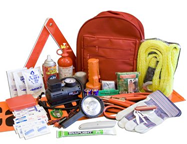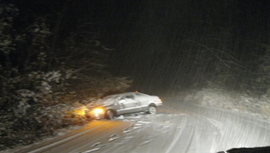Severe Weather can occur any time during the year.
Click here to view the UNH Weather Emergency Action Plan
Winter Weather Preparedness
A winter storm in New Hampshire can range from a moderate snowfall over a few hours to a Nor’easter, bringing blizzard conditions with blinding wind-driven snow that lasts several days. People can become stranded in their automobiles or trapped at home, without utilities or other services. The aftermath of a winter storm can have an impact on a community or the entire region for days, weeks or even months. Storm effects, in New Hampshire, include large snow accumulation, extremely cold temperatures, heavy, wet snow or icing on trees and power lines, closed highways and blocked roads, roof collapses, coastal flooding and beach erosion.
House fires and carbon monoxide poisoning occur more frequently in the winter due to lack of proper safety precautions when using alternate heating sources, like unattended fires and space heaters. As with most potential disasters: preparedness, monitoring the media and common sense can minimize the danger to you and your family.
Before a Winter Storm Threatens
Know the terms used by weather forecasters:
Winter Storm Watch– Be alert, a winter storm is likely in your area. Tune to radio or television for more information.
Winter Storm Warning– Take action, the storm is in or entering the area.
Blizzard Warning– Snow and strong winds combined will produce blinding snow, near zero visibility, deep drifts, and life-threatening wind chill. Seek refuge immediately.
Winter Weather Advisory– Winter weather conditions are expected to cause significant inconveniences and may be hazardous, especially to motorists.
Freezing Rain– Rain that freezes when it hits the ground, creating a coating of ice on road, walkways, trees and power lines. If a ½ inch or more of freezing rain is forecast an Ice Storm Warning will be issued.
Wind Chill Advisory / Warning– Combination of wind and cold resulting in temperatures that feel -15F
- Have an Emergency Supply Kit to survive on their own for at least three days.
- non-perishable food,
- bottled water, flashlights and extra batteries
- a portable radio in case of power outages
- Additional items that should be included are a freshly-stocked first-aid kit, essential prescription medicines, a non-electric can opener, baby-care items, extra blankets, sleeping bags and a fire extinguisher and do not forget about your pet’s needs.
- To stay warm have extra blankets or sleeping bags available. Wear layers of clothing.
- Keep fire extinguishers on hand and make sure everyone knows how to use them.
- Develop a Family Emergency Communication Plan in case family members are separated from one another during a winter storm (a real possibility during the day when adults are at work and children are at school or attending college), and have a plan for getting back together. Ask an out-of-state relative or friend to serve as the ‘family contact’. After a disaster, it is often easier to call long distance. Make sure everyone knows the name, address and telephone number of the contact person.
- Faculty, staff and students who are home owners:
- Have sufficient heating fuel, as regular sources may be cut off. Have emergency heating equipment and fuel (gas fireplace, wood burning stove or fireplace) so you can keep at least one room livable. Be sure the room is well ventilated.
- If not on an automatic fuel delivery plan, start one. Work with your fuel supplier for payment plan
- Make sure your home/apartment is equipped with working smoke detectors and carbon monoxide alarms with battery back-up.
- Make sure your home is properly insulated. Caulk and weather-strip doors and windows to keep cold air out.
- To keep pipes from freezing, let faucets drip a little to avoid freezing. Know how to shut off water valves.
- If pipes freeze, remove insulation, completely open all faucets and pour hot water over the pipes, starting where they are most exposed to the cold. A hand-held hair dryer, used with caution, also works well.


Auto Safety Tips
- Keep your gas tank full and check your windshield wiper fluid.
- Install good winter tires with adequate tread. Ensure your vehicle is maintained and in good working order.
- Keep a windshield scraper, small broom and shovel for ice and snow removal
- Plan long trips carefully, listening to the radio or television for the latest weather forecasts and road conditions. If bad weather is forecast, drive only if absolutely necessary.
- Suggested items for a Winter Emergency Car Kit include a flashlight with extra batteries, a basic first-aid kit, necessary medications, a pocket knife, booster cables or jump kit, a blanket or a sleeping bag, extra clothes (including rain gear, mittens and socks), non-perishable easily opened foods, sand for generating vehicle traction, tire chains or traction mats, a basic tool kit (pliers, wrench, screwdriver), a tow rope, a container of water and a brightly colored cloth to serve as a flag, if necessary.
- Travel during daylight hours, keep others informed of your schedule, route and if possible, take another person with you. Stay on main roads; avoid back road shortcuts.
- If a blizzard traps you in your car, pull off the highway. Turn on hazard lights and hang a distress flag from your radio antenna or window.
- Remain in your vehicle where rescuers are more likely to find you. Do not set out on foot, unless you can see a building close by where you know you can take shelter.
- Run the engine and heater about 10 minutes each hour to keep warm. When the engine is running, open the window slightly for ventilation. Periodically clear snow from the exhaust pipe.
- Exercise to maintain body heat, but avoid overexertion. In extreme cold, huddle with passengers.
- Take turns sleeping. One person should be awake at all times to look for rescue crews.
- Drink fluids to avoid dehydration.
- Be careful not to waste battery power. Balance electricity energy needs: the use of lights, heat and radio. At night, turn on the inside light so work crews and rescuers can see you.
During a Winter Storm
Stay indoors and limit travel to only absolutely necessary trips.
- If you need to go outdoors, dress for the season, wearing several layers of loose fitting, lightweight, warm clothing, rather than one layer of heavy clothing. The outer garments should be tightly woven and water repellent.
- Mittens are better than gloves.
- Wear a hat; most body heat is lost through the top of the head.
- Cover your mouth with a scarf to protect your lungs.
- Be careful when shoveling snow. Over-exertion can bring on a heart attack – a major cause of death in the winter.
- Watch for signs of frostbite: loss of feeling and white or pale appearance in the extremities such as fingers, toes, ear lobes or the tip of the nose. If symptoms are detected, seek medical help immediately.
- Watch for signs of hypothermia: uncontrollable shivering, memory loss, disorientation, incoherence, slurred speech, drowsiness and apparent exhaustion. If symptoms are detected, get the victim to a warm location, remove any wet clothing, warm the center of the body first and give warm, non-alcoholic beverages, if the victim is conscious. Get medical help, as soon as possible.
After the Winter Storm
- Stay off roads to allow plowing operations to proceed smoothly.
- Help dig out fire hydrants and storm drains in your neighborhood.
- Avoid parking too close to corners, allowing Public Safety vehicles and plows to maneuver safely.
- Be aware of children playing in the streets, particularly climbing on or running out from behind large snowdrifts.
- Parents should remind their children to be aware of plowing operations and traffic.
- Never run automobile until exhaust pipe has been cleared of snow.
- Home owners, make sure backup generators and alternative heating sources are well ventilated
- Take your time shoveling. Avoid overexertion.
- Use care around downed power lines. Assume a down wire is a live wire. Report it to authorities.
- Watch out for overhead hazards such as broken tree limbs and ice on roofs and wires.
- Home owners, make sure backup generators and alternative heating sources are well ventilated.
- Remove heavy snow from roofs; if safe to do so. Make sure gutters and drains are clear.
- Home owners, make sure backup generators and alternative heating sources are well ventilated.
Additional Winter Weather Preparedness Information:
NH Homeland Security & Emergency Management
Federal Emergency Management Agency
National Weather Service Winter Weather
Special Thanks to Boston College Office of Emergency Management